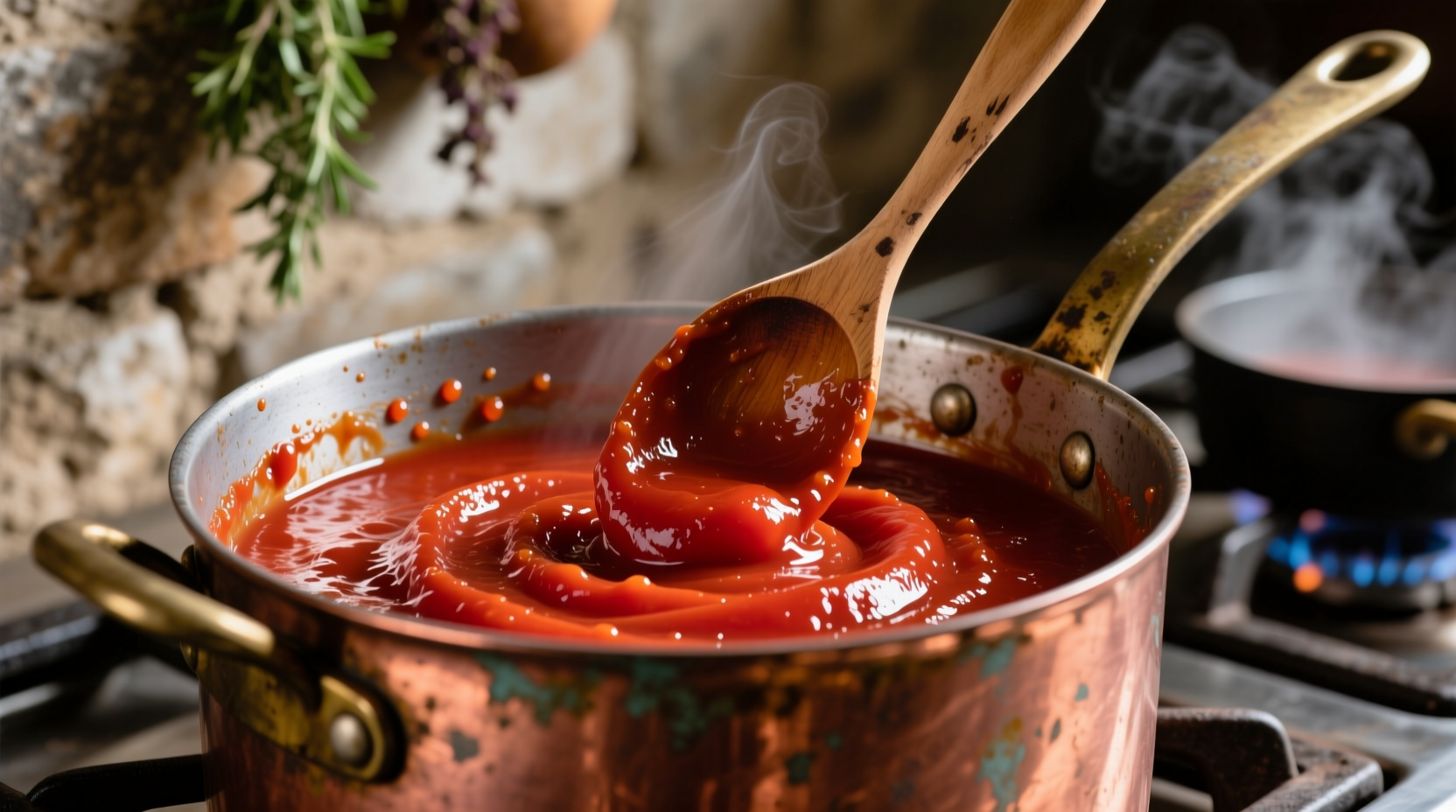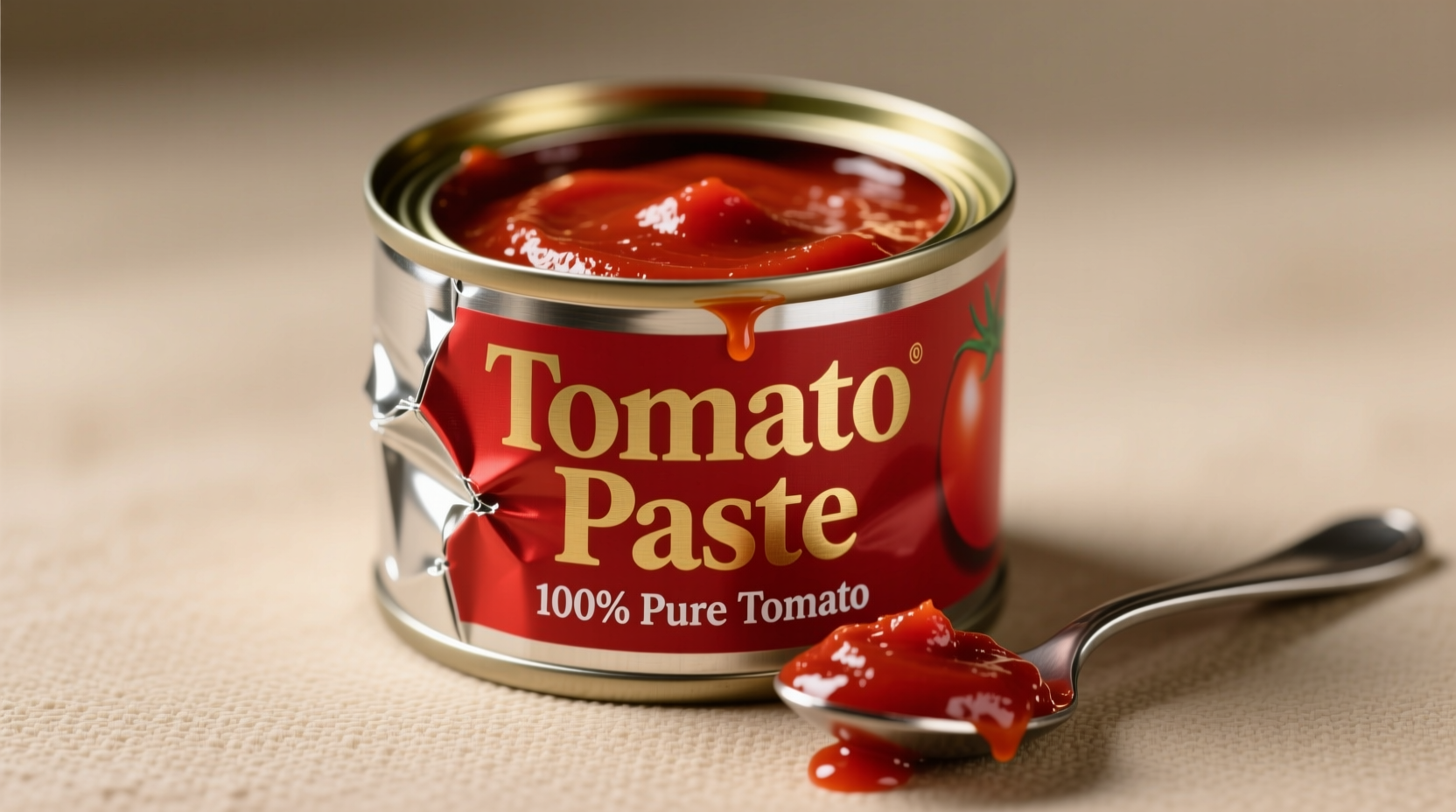Tomato paste is a thick, concentrated product made from ripe tomatoes that have been cooked down, strained, and reduced to intensify their natural sweetness and umami flavor. Unlike tomato sauce or puree, it contains no added ingredients and has approximately 24-30% tomato solids, making it the most concentrated form of processed tomatoes available for cooking.
The Essential Guide to Tomato Paste: More Than Just Concentrated Tomatoes
Understanding tomato paste transforms your cooking. This kitchen staple isn't just "thick tomato sauce"—it's a culinary powerhouse that builds depth in sauces, soups, and stews. When you know what tomato paste really is and how to use it properly, you'll elevate everyday dishes from flat to phenomenal.
What Exactly Is Tomato Paste? The Science Behind the Simplicity
Tomato paste begins as vine-ripened tomatoes that undergo a precise concentration process. According to the USDA's standards for canned tomatoes, authentic tomato paste must contain a minimum of 24% tomato solids. Most commercial varieties reach 28-30% concentration through evaporation, creating a product with intensified natural sugars and acids while preserving lycopene and other heat-stable nutrients.
The production process removes water content through slow cooking, which caramelizes natural sugars and develops complex flavor compounds. This Maillard reaction creates the deep umami notes that distinguish quality tomato paste from thinner tomato products. Unlike tomato sauce, which typically contains 8-12% solids and often includes seasonings, tomato paste contains only tomatoes—no added salt, sugar, or preservatives in its purest form.
How Tomato Paste Is Made: From Field to Can
Understanding the production timeline reveals why tomato paste delivers such concentrated flavor:
| Production Stage | Timeframe | Key Transformation |
|---|---|---|
| Harvesting & Sorting | Peak summer months | Ripe tomatoes selected for sugar content and acidity balance |
| Initial Cooking | 2-3 hours | Tomatoes cooked to break down cell structure and release juices |
| Straining | 30-60 minutes | Skins and seeds removed through fine mesh filtration |
| Concentration | 4-6 hours | Slow reduction to achieve 24-30% solids content |
| Canning & Sterilization | 20-30 minutes | Sealed containers heated to 90-95°C (194-203°F) for preservation |
This meticulous process, documented by the Food and Agriculture Organization of the United Nations in their Tomato Processing Guidelines, ensures maximum flavor concentration while maintaining nutritional integrity. The extended cooking time develops flavor compounds that raw tomatoes or less-concentrated products simply cannot match.

Tomato Paste vs. Similar Tomato Products: Know Your Ingredients
Confusing tomato paste with other tomato products leads to cooking disasters. This comparison clarifies the critical differences:
| Product | Tomato Solids | Texture | Primary Culinary Use | Water Content |
|---|---|---|---|---|
| Tomato Paste | 24-30% | Thick, spreadable paste | Flavor base for sauces, soups, stews | 70-76% |
| Tomato Puree | 8-24% | Smooth liquid, pourable | Intermediate cooking stage | 76-92% |
| Tomato Sauce | 5-8% | Thin, liquid consistency | Ready-to-use in dishes | 92-95% |
| Tomato Ketchup | 20-25% (plus additives) | Viscous, sweetened | Condiment only | 75-80% |
As noted by the American Culinary Federation's Culinary Research Department, substituting these products incorrectly alters dish chemistry. Tomato paste's high concentration means you need only 1-2 tablespoons to build flavor foundations, while using sauce instead would introduce excess liquid and dilute flavors.
When to Use Tomato Paste: Practical Applications
Professional chefs use tomato paste in three critical ways that home cooks often miss:
- Flavor foundation - Cooked in oil before adding liquids to caramelize sugars and develop deep umami notes
- Color enhancement - A tablespoon creates rich red hues in sauces without thinning consistency
- Acidity balancer - Counteracts sweetness in dishes while adding subtle tartness
For Mediterranean and Latin American cuisines specifically, tomato paste serves as the flavor cornerstone in dishes like Spanish sofrito, Italian ragù, and Mexican adobo. The University of California's Agricultural and Natural Resources department confirms that cooking tomato paste in fat for 3-5 minutes before adding other ingredients creates flavor compounds that can't be replicated with less-concentrated products.
Storage and Shelf Life: Maximizing Freshness
Once opened, tomato paste presents storage challenges. Here's how to handle it properly:
- Refrigerate in airtight container: 5-7 days
- Freeze in ice cube trays: 6-8 months (transfer to freezer bag once frozen)
- Unopened cans: 18-24 months in cool, dry place
Food safety experts at the National Center for Home Food Preservation warn that improper storage leads to rapid flavor degradation. The high acid content (pH 4.1-4.5) makes tomato paste relatively stable, but exposure to air causes oxidation that dulls flavor within days.
Smart Substitutions When You're Out of Tomato Paste
While nothing replicates tomato paste's concentrated flavor, these alternatives work in emergencies:
- Tomato puree reduction - Simmer 1 cup puree until reduced to 1/4 cup (takes 20-25 minutes)
- Sun-dried tomato paste - 2 tablespoons reconstituted sun-dried tomatoes blended with 1 tablespoon oil
- Canned tomato concentrate - Check label for 24%+ solids content (not all "concentrates" meet true paste standards)
Avoid substituting ketchup or regular tomato sauce—they contain vinegar, sugar, and other additives that alter dish chemistry. The Culinary Institute of America's Research Kitchen testing shows these substitutions change flavor profiles by up to 40% compared to authentic tomato paste.
Why Recipes Specify Tomato Paste: The Culinary Science
Recipes call for tomato paste specifically because of its unique functional properties:
- Thickening power - Adds body without flour or starch
- Flavor concentration - Delivers intense tomato essence in small quantities
- pH balance - Contributes natural acidity that enhances other flavors
- Maillard reaction catalyst - Promotes browning when cooked in fat before adding liquids
Understanding what tomato paste is and how it functions explains why professional recipes rarely substitute it. The difference between using proper tomato paste versus alternatives shows in both flavor complexity and texture—critical factors that separate amateur from expert cooking.











 浙公网安备
33010002000092号
浙公网安备
33010002000092号 浙B2-20120091-4
浙B2-20120091-4